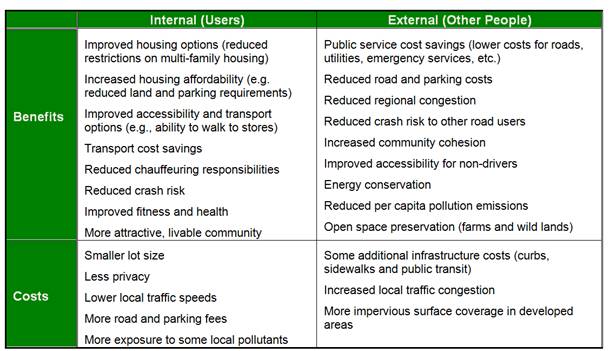This is the third in a series of columns that respond to recent claims by the National Association of Home Builders (NAHB) that smart growth policies are ineffective and harmful. The first was, An Inaccurate Attack On Smart Growth [...]
This is the third in a series of columns that respond to recent claims by the National Association of Home Builders (NAHB) that smart growth policies are ineffective and harmful. The first was, An Inaccurate Attack On Smart Growth, followed by Land Use Impacts On Travel: Current State of Knowledge. This examines smart growth benefits and costs.
First, let's clearly define the term. Smart growth refers to various land use polices that result in more compact and accessible land development, which includes increased land use density and mix (including commercial services in residential neighborhoods, and diverse housing types), increased regional accessibility and centricity, increased road and path network connectivity, increased transport system diversity, reduced and more efficiently managed parking supply. It is not simply increased density, nor simply urban growth boundaries, nor does it require eliminating single-family housing, nor is it a "war on cars."
Smart growth tends to increase resource efficiency in several ways:
- It reduces per capita land consumption and impervious surface area.
- It improves accessibility and transport diversity, which reduces per capita motor vehicle motor vehicle travel and associated costs (the costs of vehicles and fuel, roads, parking, accidents, pollution, etc.).
- It increases the efficiencies of providing utilities and public services (shorter per capita utility line and road lengths, faster emergency response, less travel required to deliver mail and pizzas, etc.).
These efficiencies provide various economic, social and environmental savings and benefits. Smart growth can also increase some costs:
- By concentrating activities and limiting urban expansion, it tends to increase land costs.
- It can increase some development costs, such as sidewalks and curbs.
- It tends to reduce privacy, increase noise and parking conflicts, and increase local traffic congestion (although total regional congestion delay tends to decline due to fewer and shorter automobile trips).
The table below summarizes these benefits and costs, categorized according to whether they are internal (impacts on the individuals who choose more compact locations) or external (impacts on other people).
Smart Growth Benefits and Costs (Burchell, et al. 2002; Litman 2010)

This table lists smart growth benefits and costs.
Critics argue that smart growth increases consumer costs, but this is not necessarily true. Some strategies (particularly urban growth boundaries) tend to increase land unit costs (dollars per acre), but other strategies reduce housing costs, by increasing development densities (less land per housing unit), reducing parking requirements, and reducing development and utility fees in more accessible areas to reflect the lower costs of providing public services in such locations. In addition, smart growth can provide substantial transport cost savings. This is why the portion of household budgets devoted to combined housing and transport costs tend to be lower in compact, multi-modal neighborhoods than in more sprawled locations. People who are truly concerned about household affordability should therefore support smart growth, particularly strategies that provide housing and transport savings.
Critics sometimes claim that smart growth costs consumers their freedom, but this is not necessarily true. Some smart growth strategies may reduce the freedom to build new, large-lot housing in sprawled, automobile-oriented locations, but North America has an abundant supply of such housing. On the other hand, smart growth policies in many ways increase consumers' freedom, including their ability to purchase more affordable, compact housing types in accessible locations, and their ability to use alternative modes. Current demographic and economic trends (aging populations, riding fuel prices, increasing health and environmental concerns, changing consumer preferences, etc.) are increasing demand for compact housing and alternative modes, so the freedoms provided by smart growth are becoming increasingly important.
Described differently, current housing and transport markets are distorted in many ways that encourage sprawl and automobile-dependency. Smart growth corrects these distortions, allowing more diverse housing types and transport options that better respond to future consumer demands.
It is important to consider all these impacts (benefits and costs) when evaluating smart growth. Current debates are often incomplete and simplistic, focusing on just a few impacts but overlooking some of the most important. For example, smart growth is generally justified primarily as a way to reduce infrastructure and environmental costs, while safety and health benefits, consumer transport cost savings, the value of improved accessibility for non-drivers, and the value of increased community cohesion (opportunities for positive interactions among people in a community) are often overlooked, although they may be of comparable value. The NAHB's publications are a good example of incomplete and biased analysis that exaggarates smart growth costs and ignores or undervalues many of its benefits.
This is an important and timely issue for planners, so it is important that we be comprehensive in our analysis. Are there any other smart growth impacts that I've overlooked?
For More Information
Pamela Blais (2010) Perverse Cities: Hidden Subsidies, Wonky Policy, and Urban Sprawl, UBC Press (http://perversecities.ca).
Robert Burchell, et al. (2002), The Costs of Sprawl 2000, TCRP Report 39, Transportation Research Board (http://onlinepubs.trb.org/onlinepubs/tcrp/tcrp_rpt_74-a.pdf)
CARB (2010), Research on Impacts of Transportation and Land Use-Related Policies, California Air Resources Board (http://arb.ca.gov/cc/sb375/policies/policies.htm).
Jonathan Ford (2009), Smart Growth & Conventional Suburban Development: Which Costs More? U.S. Environmental Protection Agency (www.epa.gov/smartgrowth/sg_business.htm); at www.morrisbeacon.com/images/documents/MBD%20EPA%20infrastructure.pdf.
Jonathan Levine, et al. (2005), "A Choice-Based Rationale for Land Use and Transportation Alternatives," Journal of Planning Education and Research, Vol. 24, No. 3, pp. 317-330 (http://jpe.sagepub.com/cgi/content/abstract/24/3/317).
Todd Litman (2008), Understanding Smart Growth Savings: What We Know About Public Infrastructure and Service Cost Savings, And How They are Misrepresented By Critics, Victoria Transport Policy Institute (www.vtpi.org/sg_save.pdf).
Todd Litman (2009), Where We Want To Be: Home Location Preferences And Their Implications For Smart Growth, Victoria Transport Policy Institute (www.vtpi.org/sgcp.pdf).
Todd Litman (2010), Evaluating Transportation Land Use Impacts, Victoria Transport Policy Institute (www.vtpi.org/landuse.pdf).
Todd Litman (2011), "Why and How to Reduce the Amount of Land Paved for Roads and Parking Facilities," Environmental Practice, Vol. 13, No. 1, March, pp. 38-46 (http://journals.cambridge.org/action/displayJournal?jid=ENP).
Todd Litman (2011), Affordable-Accessible Housing Photo Essay, Victoria Transport Policy Institute (www.vtpi.org/aff_acc_photo.pdf).
Ray Tomalty and Murtaza Haider (2008), Housing Affordability and Smart Growth in Calgary, Plan-It Calgary, City of Calgary (www.calgary.ca/docgallery/BU/planning/pdf/plan_it/housing_afford_and_smarth_growth_report.pdf).

Planetizen Federal Action Tracker
A weekly monitor of how Trump’s orders and actions are impacting planners and planning in America.

Chicago’s Ghost Rails
Just beneath the surface of the modern city lie the remnants of its expansive early 20th-century streetcar system.

Amtrak Cutting Jobs, Funding to High-Speed Rail
The agency plans to cut 10 percent of its workforce and has confirmed it will not fund new high-speed rail projects.

Ohio Forces Data Centers to Prepay for Power
Utilities are calling on states to hold data center operators responsible for new energy demands to prevent leaving consumers on the hook for their bills.

MARTA CEO Steps Down Amid Citizenship Concerns
MARTA’s board announced Thursday that its chief, who is from Canada, is resigning due to questions about his immigration status.

Silicon Valley ‘Bike Superhighway’ Awarded $14M State Grant
A Caltrans grant brings the 10-mile Central Bikeway project connecting Santa Clara and East San Jose closer to fruition.
Urban Design for Planners 1: Software Tools
This six-course series explores essential urban design concepts using open source software and equips planners with the tools they need to participate fully in the urban design process.
Planning for Universal Design
Learn the tools for implementing Universal Design in planning regulations.
Caltrans
City of Fort Worth
Mpact (founded as Rail~Volution)
City of Camden Redevelopment Agency
City of Astoria
City of Portland
City of Laramie




























